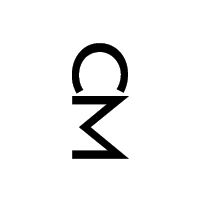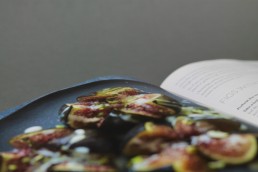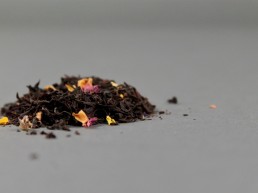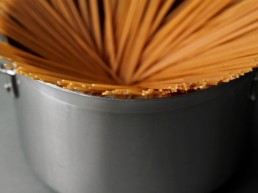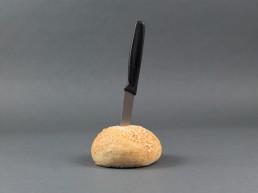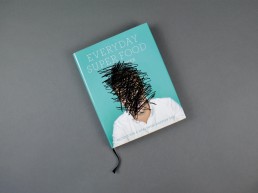The book that sparked my passion for food, Nigellissima is a celebration of the Anglo-Italian love-affair.
Anyone who knows me (most won’t admit to it) knows I’m a devotee of The Honourable Nigella Lawson. I adorn her candle lit shrine with cooked spaghetti and wads of chocolate cake on an almost daily basis. And yes, as the daughter of a Baron she really is ‘The Honourable’. Who knew?
She’s the undisputed queen of home cooking and quite possibly the closest any gay man will ever get to a meaningful heterosexual relationship. Present company included.
Despite my crush on Miss Lawson, I seriously feared I’d have to feign passion for all things edible when I qualified as a Nutritionist; smiling happily while spirilazing phallic vegetables but secretly living on a diet of potato waffles and sunny delight. Those were troubling times!
As luck would have it a certain Italian, let’s call him Pete, bought a copy of Nigellissima for me as a birthday present. I’m not sure why. It was one of those ‘oh great, thank you so much for this wonderful book …which I’ll just pop here on this dusty shelf between The Naked Chef and 101 Slow Cooker Favourites’ moments. I was already resigned to the idea I’d never use it.
Well, possibly owing to the fact Nigellissima wasn’t as thick and weighty as the bible and didn’t contain evangelical words like ‘superfood’ or ‘detox’ it very quickly won me over in a way I hadn’t anticipated and avoided the dusty shelf of no return. I’m glad it did.
Where it all began
Nigellissima is where my love of cooking and food all began. Amongst its airy pages I found food I both liked and could cook. I found my ‘way in’ to that foodie world everybody raves about. And to this day, no matter where by cookbook adventures take me, this is the book I always return to.
I also recommend this book as a starting point for anyone who wants to learn how to cook. It’s Nigella’s only ‘themed’ book to date which takes Italian food and makes it even more approachable to us poor old Brits still grappling with the idea of doing more with oil than cooking chips in it.
The ingredients lists are not only recognisable to most of us but mercifully short – such is the beauty of Italian cooking. They’re comfortingly familiar but lure you into venturing just a tad further into the Italian pantry without losing your nerve. It’s this balance of the familiar with the ever so slightly exotic (if we can call cannellini beans exotic!) that make this book so ‘right’.
Thankfully most of us are just as familiar with spaghetti Bolognese as we are with shepherd’s pie these days which is testament to Britain’s long standing love-affair with Italian food, though I will admit to remembering my Mum having to go to the pharmacy for Olive oil when I was little; one of the only places you could get it back in dinosaur times.
Gorgeous salty juices
Now ordinarily this is where most cookbook praise would end but this is Nigella we’re talking about – duh! If you’ve never actually read a Nigella book before but instead found yourself lulled into her world of “gorgeous salty juices” and “stiff peaks” on TV you’re in for a surprise. Something that gets (I think deliberately) watered-down in the media is that Nigella is a literary behemoth. The lady can write.
But here’s the proverbial cherry on the ‘yes it’s laced with fat and sugar’ cake: Nigella is one of the few people in food who writes just as she speaks. So what? Well, if you’re a bit of a nervous cook, a ‘does that look burnt to you?’ or ‘is that too lumpy?’ sort of person, the beauty of Nigella’s writing is that it’s as though she’s stood in the kitchen with you and pre-empts every moment you’re likely to panic. Perhaps this is why I, like so many Nigella disciples, cling to her books like a buoyancy aid in a sea of lumpy gravy! It’s definitely why I recommend this particular book to people who are just starting out in the kitchen.
Nigellissima has an unusual honesty about it in a world where cookbooks often wreak of moral judgements – what!? you mean you don’t buy fresh edamame from a Japanese street vendor in Kensington?!
It’s what this book doesn’t say that makes it so good. The ingredients lists are short and inexpensive. The photos are unusually muted and un-intimidating and much of its contents could easily be classified as ‘healthy’. There’s not even a salad in a jar. Result!
This is the perfect book if you’re just starting to get into food and nutrition without the worry of having to make some kind of incorruptible statement or being judged. Here you’re allowed to enjoy food without reason. Here the food does the talking so you don’t have to.

